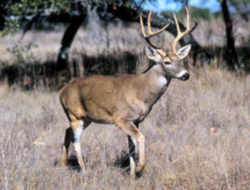
State Mammals
State Animals - White-tailed Deer
Odocoileus virginianus

Whitetail deer are able to survive in a variety of terrestrial habitats, from the big woods of northern Maine to the deep saw grass and hammock swamps of Florida. They also inhabit farmlands, brushy areas and such desolate areas of the west such as the cactus and thorn brush deserts of southern Texas and Mexico. Ideal whitetail deer habitat would contain dense thickets (in which to hide and move about) and edges (which furnish food).
There are 16 subspecies of white-tailed deer in North America. Subspecies are distinguished by geographic location, body size, coloration, antler growth, and physiological, biochemical, and behavioral differences .
State Animals and/or Mammals: White-tailed Deer |
|
|---|---|
State |
Adopted |
| Arkansas White-tailed Deer | 1993 |
| Illinois White-tailed Deer | 1982 |
| Michigan White-tailed Deer | 1997 |
| Mississippi White-tailed Deer | April 12, 1974 |
| Nebraska White-tailed Deer | February 26, 1981 |
| New Hampshire White-tailed Deer | 1983 |
| Ohio White-tailed Deer | 1988 |
| Oklahoma White-tailed Deer | |
| Pennsylvania White-tailed Deer | October 2, 1959 |
| South Carolina White-tailed Deer | 1972 |
| Wisconsin White-tailed Deer | 1957 |
| Deer Family | |
| Utah Rocky Mountain elk (Cervus canadensis) |
February 1, 1971 |
| Vermont White-tailed Deer The white-tail is depicted on the state flag and seal. |
|
| White-tailed deer is the most popular of official state animals and/or mammals, representing eleven states, from New Hampshire south to Mississippi and west to Nebraska and Oklahoma. The only other species representing more states is the honeybee, the state insect of at sixteen states. | |
Habitat
- O. virginianus ssp. borealis: from central Ontario and Quebec south to southern
Illinois, and from central Minnesota to the East Coast - O. virginianus ssp. clavium: Florida Keys
- O. virginianus ssp. couesi: central Arizona south through Mexico and southwestern
New Mexico - O. virginianus ssp. dakotensis: southern Northwest Territories west into central
Saskatchewan and Manitoba, and south through Alberta, the Dakotas, eastern Montana, central Wyoming, northern Colorado, and western Minnesota - O. virginianus ssp. hiltonensis: Hilton Head Island, South Carolina
- O. virginianus ssp. leucurus: southwestern Washington and the western quarter of
Oregon - O. virginianus ssp. macrourus: Iowa, Missouri, Arkansas, northern Louisiana, eastern Texas, Kansas, and Nebraska, and southeastern South Dakota
- O. virginianus ssp. mcilhennyi: southeastern Texas and southern Louisiana
- O. virginianus ssp. nigribarbis: Blackbeard Island, Georgia
- O. virginianus ssp. ochrourus: British Columbia to western Alberta, south through
western Montana, Idaho, eastern Washington and Oregon, western Wyoming, northern Utah, and possibly a fringe of the border between northern California and Nevada - O. virginianus ssp. osceola: midwestern Florida, north into southern Alabama and
Mississippi - O. virginianus ssp. seminolus: Florida
- O. virginianus ssp. taurinsulae: Bulls Island, South Carolina
- O. virginianus ssp. texanus: Nebraska, Kansas, Oklahoma, Texas, western New Mexico
and Colorado, and southeastern Wyoming - O. virginianus ssp. venatorius: Hunting Island, South Carolina
- O. virginianus ssp. virginianus: Kentucky, West Virginia, Virginia, Tennesee, North Carolina, South Carolina, Georgia, Mississippi, and Alabama
Scientific name
Deer make up the family Cervidae of the order Artiodactyla. The European elk, or moose, is classified as Alces alces. South American pudus make up the genus Pudu, and musk deer the genus Moschus. The Chinese water deer is classified as Hydropotes inermis, and the caribou, or reindeer, as Rangifer tarandus. The red deer make up the genus Cervus, and the roe deer the genus Capreolus. The white-tailed deer, or Virginia deer, is classified as Odocoileus virginianus; the mule, or black-tailed, deer as Odocoileus hemionus; and the American elk, or wapiti, as Cervus elaphus.
The genus name Odocoileus is from the Greek words odon (tooth) and koilos (hollow) or "hollow tooth," in reference to the depressions in the crown of the molar teeth. The Latinized species name virginianus (of Virginia) refers to the state from which the species was first collected and described.
Taxonomic Hierarchy: White-tailed Deer
Kingdom: Animalia
Phylum: Chordata
Class: Mammalia
Order: Artiodactyla
Family: Cervidae
Subfamily: Capreolinae
Genus: Odocoileus
Species: O. virginianus





